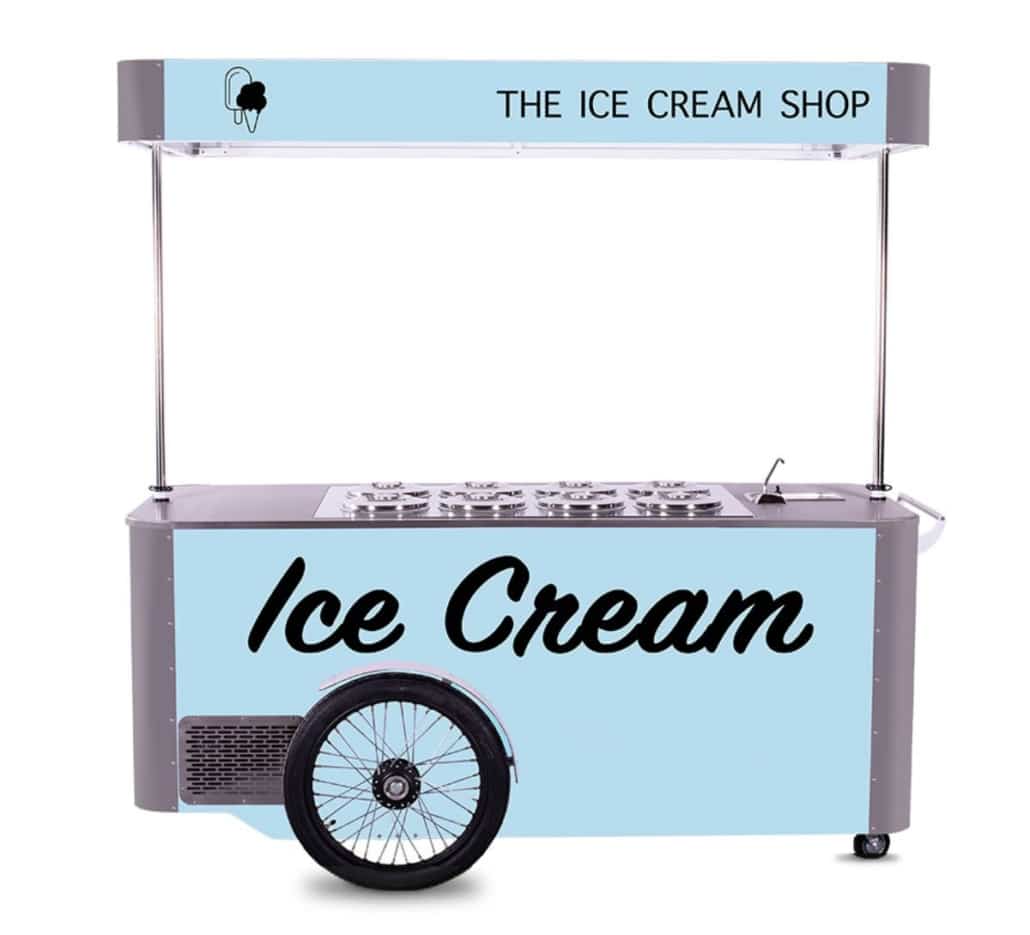How to Start an Ice Cream Cart Business
Did you know that Europeans buy, on average, about 9 kg of ice cream per year?
Same goes for US: the average American consumes 22 lbs of ice cream every year.
In fact, the ice cream demand is so great, the ice cream industry produces more than 870 million gallons of it every year, generating over $5 billion in 2014 alone.
However, before you run off to start your own mobile ice cream shop, you need to understand several important aspects that are specific to this niche. Hopefully, by the time you finish reading this post, you’ll have a clear idea of exactly what you need to do in order to turn your appreciation of ice cream into a fresh source of monthly income. So let’s get started, shall we?
How to Start an Ice Cream Cart Business
1. Things to Consider: Challenges and Hidden Opportunities
As with any vending business, an ice cream cart venture has its specific challenges and opportunities and it’s entirely up to you to make them work in your favor.
For example, the greatest challenges ice cream carts owners face are the ones related to their local council’s street food regulations that usually address the vending carts equipment and the trading locations.
At the same time, seasonal limitations should also be considered: if you live in an area where the weather tends to be drafty and wet most of the time, selling ice cream outdoor would be a challenge, to say the least. Add to that the convenience of supermarket shopping and you get the full picture of an ice cream cart business’ limitations.
However, the “when one door closes, another one opens” adage successfully applies in this case: many ice cream cart vendors work around these restrictions by catering to fairs, private events, and parties. And, according to our customers, one of the most lucrative sub-niche is renting the ice cream cart to weddings and birthday parties.
Other advantages of an ice cream cart business are low start-up costs, excellent profit margins, minimal waste, and little skill required (unless you prepare the ice cream yourself).
2. Find Out the Legal Requirements of an Ice Cream Cart Business
Thorough research and planning will help tremendously, especially since legislation concerning street food vending varies from one country to another and even from one city to another.
The legal requirements don’t only determine what and where you’re allowed to sell; they also determine your vending cart’s equipment. We often adapt our carts, including ice cream vending carts, to fulfill regulations concerning hot & cold water supply, waste disposal, and so on.
So, the first thing you should do is to contact your local Health Department or the Department of Environmental Services in your area and address the following issues:
- The street food vending regulations in your city;
- The types of food you’ll be selling and how they’re handled, stored, and served;
- Commissary requirements (the requirement to operate from a licensed commercial kitchen)*;
- The size, make and the equipment of the ice cream vending cart;
- The cart’s fresh water and waste water holding capacity;
- Safe food handling course requirement;
- Hygiene policies;
- Pre-approval inspection of the equipment.
* In the US, most municipalities don’t allow street food vendors to operate a food service business from a residential kitchen and they require the use of a commissary – a licensed and inspected commercial kitchen. Vendors have to report to the commissary each day of operation to prepare the food that will be served from the cart and to clean the cart’s equipment at the end of the day. However, since you’ll be selling frozen desserts, check if this applies in your case.
After learning about the health and safety requirements, you should the contact the Business License Department and find out what you need to obtain your business license.
If you’re planning to advertise on mobile billboards, you should also check if there’s a limit on the maximum amount of signage you are allowed to use.
Legal Requirements, in short
Most of our customers said the requirements usually involve a health permit, a food handling permit, an ice cream vendor permit, a business license and insurance. You might also need a criminal background check before the permits can be issued to you
3. Research Target Market and Locations
Make a list with street vending locations
Start by making a list of all the places with good vending potential in your area. The list should include include neighborhoods occupied by families, parks, shopping centers, swimming pools, beaches, fairs and festival locations, and other places where children and adults frequently go.
Remove those where street vending is restricted and highlight the ones that seem most attractive to you.
Brainstorm catering opportunities
After refining the first list, make a second one that addresses catering to private events and parties. An ice cream vending cart can be the center of attention at company picnics, community get-togethers, fairs, festivals, parades, fundraisers, birthday parties, engagement parties, weddings and more.
The idea of having soft-serve ice cream desserts at private celebrations and social events is a huge hit with the customers, and the best part is that parties always lead to more parties. Virtually every event you’ll attend could bring in future business, but this also means you’ll have to rise up to the occasion and be the best in what you do!
4. Research Your Competition
As a first time entrepreneur, you should thoroughly research all the aspects of your future business, and sizing up your competition is a crucial part of this stage. Who else sells ice cream in your area? Visit each one of them and observe how they’re operating their business. Pay attention to things such as:
- Vendor’s attitude;
- What are they doing right;
- What are they doing wrong;
- What are the things you could do better;
- What kinds of ice cream, toppings, and sides they’re selling;
- Unique flavours and combinations;
- Best selling products;
- Particular customer preferences;
- Marketing and branding.
Write all these things down as they will help you create your menu, your pricing structure, and your marketing strategy.
5. Create Your Ice Cream Cart Business Plan
This step is all about planning, since you can’t start and operate a successful business without a good business plan. Writing it down will give you a clear direction and keep you from making costly financial mistakes, especially in the beginning.
Your business plan should cover:
Budget
- Legal expenses for obtaining licenses and permits;
- Ice Cream Vending Cart price;
- Insurance;
- Operational cost for the first 1-2 months;
- Initial stock costs ( 1-2 months);
- Incidental costs: napkins, plasticware, to-go containers, etc;
- Marketing and advertising expenses.
Marketing Strategy and Sales Strategy
How do you plan to market and advertise your business? You could:
- Throw opening party to let locals know you’re open for business;
- Engage in community events to sell your products;
- Advertise your products in your local media;
- List your business on local & online directories;
- Create a landing page for your business;
- Leverage the power of social media;
- Engage in direct marketing and sales;
- Encourage the use of Word-of-Mouth marketing (referrals);
6. Things to Consider
– Decide what you want to sell: high-end, artisanal ice-cream, frozen yogurts, popsicles, or any other variation of ice cream products. Write down all your ideas and then pick one that most excites you.
Picking one or two products as your specialty matters more than you think. If you try being all things to all people, you may have the opportunity to draw in more customers, but you’ll also have to stock accordingly.
On the other hand, if you pick a specialty or two, you can offer a product that a smaller group loves and build yourself a loyal following. And by doing so, you can charge significantly higher margins for your specialty product.
Then there’s a mater of equipment. Selling prepackaged ice cream doesn’t require much in terms of appliances and an ice cream cart equipped with a 98L freezer is perfect for the job. Gelato comes with different requirements concerning storage and handling. But a gelato cart fitted with a pozzetti system and one or two sinks is usually the standard.
– Make sure people know where to find you if you move around often. You could use Facebook and Twitter to tell customers where you are. You can also do this on your website if you decided to have one.
– Learn to upsell. If a customer orders a scoop of ice cream, ask if she would like to make it a double or if she would like sprinkles and a cherry.
– Have popular flavors on hand, and even unusual ones, such as jalapeno apricot. Vanilla is the most popular ice cream flavor, followed by chocolate chip mint and cookies & cream.
– Stay open on days you’re likely to garner more sales, such as Sunday and Monday. Cold Stone Creamery reports that Sunday is the most popular day for ice cream sales. According to Mashable, food trucks are busiest on Mondays.
– Brand yourself! Find a catchy name, and decide on a style that will reflect your business and its personality. Branding also means consistency, so make sure that all your promotional materials, design and copywriting wise, stay true to your identity and brand message!
The Conclusion
Starting and running a mobile ice cream stand business is a lot of work, but if you do it right, it’s not only rewarding, it’s also a lot of fun.
What’s more is that you get to be your own boss and brighten people’s lives on a daily basis, and these are great personal motivators.
Good luck and, if you have questions, contact us anytime.
Get an Ice Cream Cart Quote!











